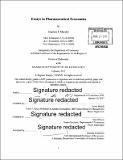| dc.contributor.advisor | Ernst Berndt and Sara Ellison. | en_US |
| dc.contributor.author | Murphy, Stephen J. (Stephen James) | en_US |
| dc.contributor.other | Massachusetts Institute of Technology. Department of Economics. | en_US |
| dc.date.accessioned | 2017-05-11T20:00:25Z | |
| dc.date.available | 2017-05-11T20:00:25Z | |
| dc.date.copyright | 2017 | en_US |
| dc.date.issued | 2017 | en_US |
| dc.identifier.uri | http://hdl.handle.net/1721.1/109009 | |
| dc.description | Thesis: Ph. D., Massachusetts Institute of Technology, Department of Economics, 2017. | en_US |
| dc.description | Cataloged from PDF version of thesis. | en_US |
| dc.description | Includes bibliographical references. | en_US |
| dc.description.abstract | This thesis consists of three empirical essays in pharmaceutical economics, which explore the role regulation plays in influencing firm behavior. In the first chapter I examine competition in the neglected disease submarket of the biopharmaceutical industry. Using a combination of novel panel data sources that cover both pharmaceutical firms innovation activities as well as the approved product market behavior, I estimate the causal effect of the introduction of the United States 2002 Rare Disease Act, and the European Union 2000 Orphan Drug Act on the equilibrium flow rate of new orphan drug candidate entry into the pharmaceutical research and development pipeline. I further implement new methods in robustness analysis including specification curve analysis and meta-regression. In the second chapter I examine competition in the research and development-intensive biopharmaceutical industry. Using a combination of novel data sources that cover both upstream pharmaceutical innovation and downstream products, I estimate the causal effect of final market size on each stage of the innovation process. I further propose and test a network model of therapy markets to study how firms endogenously reallocate within technology space in response to the negative market shock of generic penetration. In the third chapter I analyze the forces that shaped generic entry and competition in the United States pharmaceutical market over the last decade. Specifically, I find evidence that market size, payer type, distribution channel, and particular characteristics of the disease category all contribute to the ultimate amount of entry in a market. I further document evidence on the nature of competition among generic entrants, including some evidence of a first mover advantage as well as persistent price dispersion among generic entrants. Finally, I employ an instrumental variables approach to estimate the effect of marginal generic entry on price and generic diffusion within the market. | en_US |
| dc.description.statementofresponsibility | by Stephen J. Murphy | en_US |
| dc.description.tableofcontents | Chapter 1. Regulatory incentives for innovation in the orphan drug market -- chapter 2. Market size and innovation in research and development intensive industries -- chapter 3. Entry dynamics of the generic pharmaceutical industry. | en_US |
| dc.format.extent | 171 pages | en_US |
| dc.language.iso | eng | en_US |
| dc.publisher | Massachusetts Institute of Technology | en_US |
| dc.rights | MIT theses are protected by copyright. They may be viewed, downloaded, or printed from this source but further reproduction or distribution in any format is prohibited without written permission. | en_US |
| dc.rights.uri | http://dspace.mit.edu/handle/1721.1/7582 | en_US |
| dc.subject | Economics. | en_US |
| dc.title | Essays in pharmaceutical economics | en_US |
| dc.type | Thesis | en_US |
| dc.description.degree | Ph. D. | en_US |
| dc.contributor.department | Massachusetts Institute of Technology. Department of Economics | |
| dc.identifier.oclc | 986529347 | en_US |
